Web presence website Weight 233 kg Retired January 2001 Makuuchi rank Yokozuna | Debut March 1988 Role Professional wrestler Record 654-232-181 Name Akebono Taro Height 2.03 m | |
 | ||
Highest rank Yokozuna (27 January 1993) Spouse Christiane Reiko Kalina (m. 1998) Similar People | ||
Challenge | Taro Akebono
Akebono Tarō (曙 太郎, Akebono Tarō, born Chadwick Haheo Rowan; 8 May 1969) is an American-born Japanese professional wrestler and former sumo wrestler from Waimānalo, Hawaii. Joining the professional sport in Japan in 1988, he was trained by pioneering Hawaiian sumo wrestler Takamiyama and rose swiftly up the rankings, reaching the top division in 1990. After two consecutive yusho or tournament championships in November 1992 and January 1993 he made history by becoming the first non-Japanese-born wrestler ever to reach yokozuna, the highest rank in sumo.
Contents
- Challenge Taro Akebono
- Early life
- Early career
- Promotion
- Yokozuna era
- Fighting style
- Retirement
- Kickboxing and MMA career
- World Wrestling Entertainment 2005
- All Japan Pro Wrestling 2005
- New Japan Pro Wrestling 20062007
- Hustle 20072009
- Dragon Gate 20082010
- Pro Wrestling Zero1 20092013
- Return to AJPW 20092015
- d 2015present
- Personal life
- In wrestling
- Mixed martial arts record
- Professional wrestling
- Other accomplishments
- References
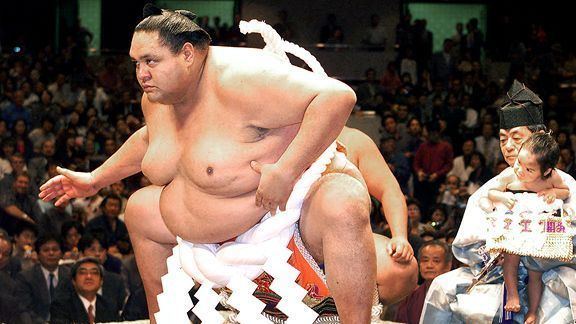
One of the tallest and heaviest wrestlers ever, Akebono's rivalry with the young Japanese hopefuls, Takanohana and Wakanohana, was a big factor in the increased popularity of sumo at tournament venues and on TV in the early 1990s. During his eight years at the yokozuna rank, Akebono won a further eight tournament championships, for a career total of eleven, and was a runner-up on thirteen other occasions, despite suffering several serious injuries. Although his rival yokozuna Takanohana won more tournaments in this period, their individual head-to-heads remained very close.

Akebono became a Japanese citizen in 1996, and after retiring in 2001 he worked as a coach at Azumazeki stable before leaving the Sumo Association in 2003. After an unsuccessful period as a K-1 fighter, he is now a professional wrestler. In All Japan Pro Wrestling (AJPW) he has been a two-time Triple Crown Heavyweight Champion, two-time World Tag Team Champion, and two-time All Asia Tag Team Champion.
He is currently under contract with Rizin Fighting Federation.
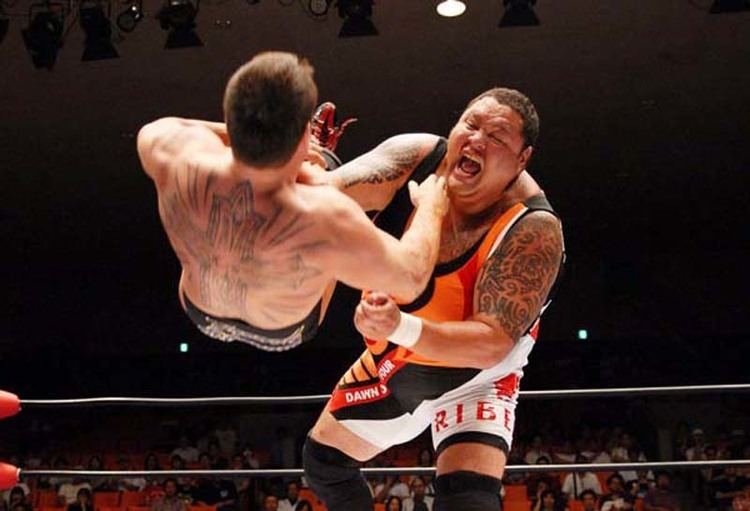
Early life
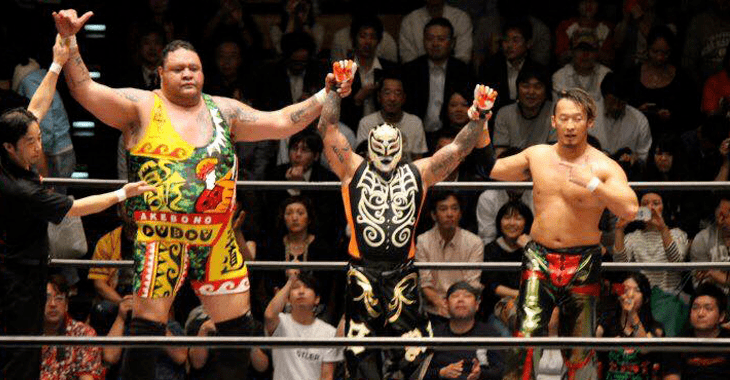
Chad Rowan was born on 8 May 1969 to Randolph and Janice Rowan, and is of Hawaiian descent. He grew up with two younger brothers, one of whom, Ola, also became a sumo wrestler for a brief period after Chad. He attended Kaiser High School, where he played basketball and became an All-Star center. He went to Hawaii Pacific University on a basketball scholarship, but sat out his freshman season.
Early career
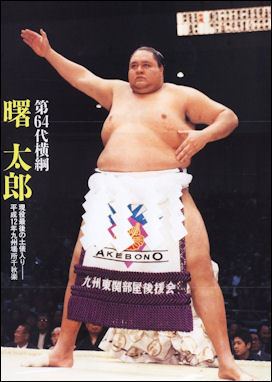
Rowan was planning to study for a career in hotel management, but he had always been interested in sumo from watching television broadcasts. A family friend introduced him to Azumazeki Oyakata, the former Takamiyama, who also originally hailed from Hawaiʻi. Azumazeki overcame his initial concerns that Rowan might be too tall and his legs too long for sumo and agreed to let him join his Azumazeki stable, founded in 1986. Rowan flew to Japan in early 1988. Adopting the shikona of Akebono, meaning "new dawn" in Japanese, he made his professional debut in March 1988. This entry cohort was one of the most successful ever, producing two other yokozuna, Takanohana and Wakanohana (sons of the popular champion from the 1970s, Takanohana Kenshi), as well as a great ōzeki, Kaiō.
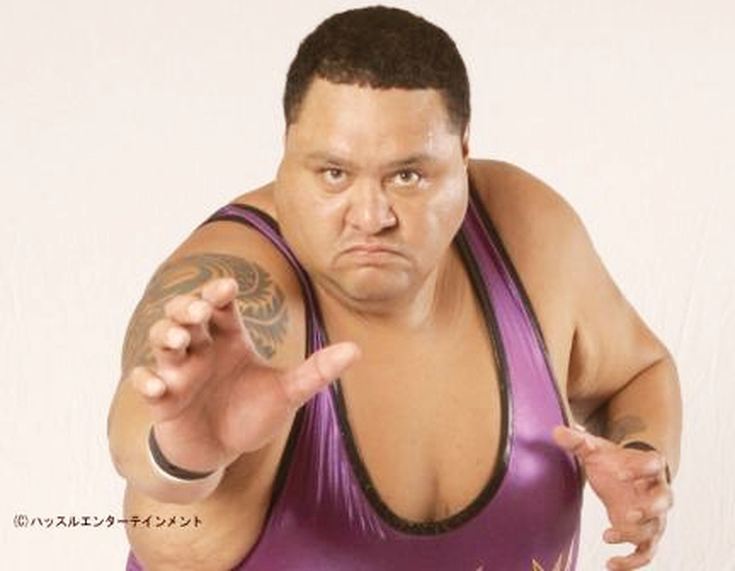
Akebono rose rapidly through the ranks, equaling the record for the most consecutive kachi-koshi (majority of wins in a sumo championship) from debut, reaching sekiwake before suffering his first make-koshi losing record. He was promoted to jūryō in March 1990, the first sekitori from his stable, and to makuuchi in September of the same year. He made his top division debut in the same tournament as Wakanohana, as well as Takatōriki and Daishōyama. In the November 1990 tournament he was awarded his first special prize, for Fighting Spirit, and in January 1991 he earned his first gold star for defeating yokozuna Asahifuji. In March 1991 he defeated ōzeki Konishiki in the first ever match between two non-Japanese wrestlers in the top division.
Promotion
In 1992, after a year of 8–7 or 7–8 records near the top of the makuuchi division, Akebono suddenly came alive with a 13–2 record in January of that year, narrowly losing the top division championship to Takanohana. A second 13–2 record two tournaments later, in May, saw him win the top division championship for the first time, and with it promotion to ōzeki. After an injury during the summer, he went on to win consecutive championships in November 1992 and January 1993 to win promotion to yokozuna.
At the time of his promotion, the rank of yokozuna had been vacant for 8 months (an exceedingly rare occurrence) and his promotion, despite the fact that he was the first foreign yokozuna, was welcomed by many. He had met the stipulation of winning two consecutive tournaments that had been mentioned by the Yokozuna Deliberation Council when turning down Konishiki the previous year, and was also seen as having conducted himself with the dignity and humility necessary for such an exalted rank. One commentator remarked, "He makes me forget he is a foreigner because of his earnest attitude towards sumo."
Yokozuna era
Akebono was a long-standing and strong yokozuna, lasting nearly eight years in the rank and winning the top division championship on a further eight occasions. His career highlights include the rare achievement of winning the top division championship in three consecutive tournaments, in 1993. In July 1993 he beat Takanohana and Wakanohana in consecutive matches to win the honbasho when all three ended up tied at the end of the 15-day tournament, and in May 1997 he defeated Takanohana twice on the final day, once in their regular match and once in a playoff, to win his first title in over two years. The competition between Akebono and Takanohana, who reached yokozuna himself in 1995, was said to be one of the great defining rivalries of postwar sumo. The two finished their careers with a 25–25 tie in bouts against one another. At the opening ceremony of the 1998 Winter Olympics in Nagano, a professional sumo wrestler was chosen to represent each of the competing countries and lead them into the stadium. After Takanohana fell ill, Akebono was given the honor of representing Japan in the opening ceremony. Akebono also led other sumo wrestlers in a ring cleansing ceremony at the Opening Ceremony (also meant to cleanse the stadium itself).
Akebono was quite susceptible to injury because of his height and weight. He suffered his first serious knee injury in May 1994 when, after winning his first ten matches, he lost a bout to Takatōriki and fell awkwardly. He flew to Los Angeles and underwent career-saving surgery. From November 1998 to March 1999 he missed three successive tournaments due to a herniated disc in his lower back and faced calls for his retirement. However, after receiving the personal backing of the Chairman of the Japan Sumo Association, he scored a respectable 11–4 record in his comeback tournament in May 1999. In 2000 he enjoyed his first completely injury-free year since 1993 and won two tournaments, finishing as runner-up in three others. He won 76 bouts out of a possible 90, the best record of any wrestler that year.
Fighting style
Akebono was one of the tallest sumo wrestlers ever, at 203 cm (6 ft 8 in) tall, and also one of the heaviest with a fighting weight around 235 kg (518 lb). He was also one of the most aggressive and ferocious sumo wrestlers. Despite having long legs, considered a disadvantage in sumo as it tends to make one top heavy and susceptible to throws, he covered for this by training exceptionally hard, and using his long reach to thrust his opponents out of the dohyō (ring). In his prime, he had incredible thrusting strength and on many occasions would blast lesser wrestlers out of the ring in one or two strokes using tsuppari techniques. His most common winning kimarite was oshi-dashi, a simple push out, and he also regularly won by tsuki-dashi, the thrust out. In later years he also used his reach to more often grab his opponent's mawashi, or belt, and then use his weight and power to force the opponent from the ring by yori-kiri. He liked a migi-yotsu, or left hand outside, right hand inside grip, and was fond of using his left hand to employ uwatenage, or overarm throw.
Retirement
After winning his eleventh top division title in November 2000, he suffered another injury and, after sitting out the tournament in January 2001, he decided to retire rather than face a daunting struggle back to fighting fitness. After his retirement, he became a member (or elder) of the Japan Sumo Association as a coach, or oyakata, and worked with his former mentor in the Azumazeki stable. He helped train the Mongolian wrestler Asashōryū who also became a yokozuna, and Akebono instructed him on how to perform the dohyō-iri, or yokozuna ring-entering ceremony.
While an oyakata, Akebono also appeared in TV commercials and opened a restaurant called ZUNA.
In June 2013 he returned to Azumazeki stable for the first time since leaving the Sumo Association to oversee some training sessions as an assistant instructor.
Kickboxing and MMA career
Akebono left the Sumo Association in November 2003 to join K-1. The decision was influenced by financial problems due to the failure of his restaurant, among other financial difficulties. His koenkai, or supporters network, had dissolved after his marriage in 1998, depriving him of a valuable source of income. In addition, he earned far less as an oyakata than he had as a yokozuna. K-1 offered him a chance to clear his debts by fighting for them.
He has managed only one win in 14 bouts in K-1 and mixed martial arts career. Because of this, he has been referred to as "Makebono" (make meaning "lose" in Japanese) by some fight fans and magazines in Japan.
Akebono had his MMA debut in K-1 before Ultimate Fighting Championship pioneer Royce Gracie. Although he was initially able to pass Gracie's guard briefly and fend him off, he was eventually submitted with an omoplata/wrist-lock combination. Akebono returned to the event the next year, fighting Bobby Ologun. The sumo champion neutralized Ologun's striking by taking him down and smothering during the earlier rounds, but he was stunned by a barrage of punches and controlled for the rest of the match, losing the decision. His third match would be against UFC champion Don Frye, who ended the match with a guillotine choke after controlling the fight on the feet. Akebono's last MMA match met professional wrestler Giant Silva, who made Akebono tap out to a kimura from under in one minute.
Akebono fought a rematch against Bob Sapp on 31 December 2015, at Rizin Fighting Federation Grand Prix event. He lost the fight by technical decision.
World Wrestling Entertainment (2005)
On 31 March 2005, Akebono made an appearance on SmackDown! to accept the Big Show's challenge to a (kayfabe) sumo match at WrestleMania 21. Akebono made his wrestling debut later that night, defeating jobber Eddie Vegas. At WrestleMania 21, Akebono defeated Big Show with a koshinage, throwing him entirely out of the ring.
On 1 July, Akebono made an appearance in a house show in Japan to help Big Show during a match against Carlito after Carlito's bodyguard Matt Morgan had interfered. The next day, Akebono teamed with Big Show to defeat Carlito and Morgan in a tag team match.
All Japan Pro Wrestling (2005)
On 4 August 2005, Akebono made his official wrestling debut in Japan, appearing at AJPW's WRESTLE-1 event against the Great Muta in the first match of the WRESTLE-1 Grand Prix Tournament, in a losing effort. the same month, it was announced that Akebono had been hired by AJPW and placed under the tutelage of Keiji Mutoh, the Great Muta's true identity. Akebono took on the role of Mutoh's enforcer and forming a tag team called "Mutoh Room" to combat the heel stable VOODOO-MURDERS. On 19 November, Akebono defeated VOODOO-MURDERS member Giant Bernard in a singles match. The same night, Akebono appeared in a match between The Great Muta and the imposter The Great Ruta to defend Muta from VOODOO-MURDERS, showing his own Muta impersonation called The Great Bono.
Later, Akebono and Mutoh competed in the Real World Tag League 2005, during the tournament, making it all the way to the finals, but were defeated by Team 3D. At the end of the year, Akebono won the Tokyo Sports award for "Rookie of the Year" and "Team of the Year" with Mutoh, who then stated that Akebono had successfully graduated from his lessons, and was then released from his contract to move to other companies and gain experience.
New Japan Pro Wrestling (2006–2007)
On 4 January 2006, Akebono appeared in New Japan Pro Wrestling (NJPW) alongside Yutaka Yoshie in a match against Black Strong Machine & Hiro Saito, coming out victorious. Later that month, Akebono competed for Pro Wrestling NOAH, teaming up with his old friend Takeshi Rikio to defeat Junji Izumida and Kenta Kobashi. After the match, Akebono announced that he had been hired by NJPW and was congratulated by Rikio, promising to team again future, which never happened due to Rikio having to retire due to his injuries in 2010.
In February, Akebono made his official debut in New Japan as an ally of Riki Choshu, defeating then IWGP Tag Team Champions Cho-Ten (Masahiro Chono and Hiroyoshi Tenzan). On 19 March, he faced Brock Lesnar for the IWGP Heavyweight Championship, but was defeated when Lesnar got the pinfall after hitting him with the title. Months later, after the championship had become vacant, Akebono participated in a tournament for it, defeating Hiroyoshi Tenzan in the first round, but being eliminated by Giant Bernard in the second.
In October, Akebono and Choshu participated in the 2006 G1 Tag League, advancing to the last round before losing to Takashi Iizuka and Yuji Nagata. In August 2007, Akebono participated in the G1 Climax tournament defeating the likes of Togi Makabe and Hiroyoshi Tenzan, but coming up short in the end. In October, Akebono and Masahiro Chono competed in the 2007 G1, beating Hirooki Goto and Milano Collection AT, Naofumi Yamamoto and Takashi Iizuka and Manabu Nakanishi and Yuji Nagata, but were eliminated in the final stage by Giant Bernard and Travis Tomko. During his stay at New Japan, Akebono began to show his comedic side and began imitating and parodying other fighters. On 13 September 2006, Akebono was presented with a tiger mask and the name of Bono Tiger to team with Tiger Mask IV. On 4 March 2007, he made a brief appearance in Michinoku Pro Wrestling as The Great Bonosuke, fighting on the side of The Great Sasuke wearing the same outfit. On 17 February 2007, Akebono briefly returned to All Japan Pro Wrestling to team with Toru Owashi against Johnny Dunn and SUMO Rikishi in an extravagant match between sumos, resulting in a win for his team. After training with Satoru Sayama (the original Tiger Mask) in MMA and pro wrestling, he returned to the New Japan ring to participate in the 2007 G1 Climax tournament. He defeated Togi Makabe and Hiroyoshi Tenzan but failed to progress to the semifinal stage.
Hustle (2007–2009)
Akebono debuted in Hustle in 2007, being the storyline son of Yinling and The Great Muta. Under the name Monster Bono, Akebono was introduced being unrealistically born from a giant egg (a parody of the Gobbledy Gooker in the World Wrestling Federation) before easily defeating RG in his first bout. After that, Monster Bono (who had a simple, childlike personality), under the control of his mother, entered the service of Takada Monster Army and competed against several other wrestlers in a winning streak. However, due to the constant abuse from Yinling, and wanting to meet his father, Monster Bono rebelled against it and left the Monster Army, changing his name to Bono-chan and allying with A-chan and Yoshie-chan to form a sumo-style face stable. Soon after, Yinling faced Bono-chan and demanded that he return to the Monster Army, but the outcome of the battle was a victory for Bono-chan, and Yinling (kayfabe) died under his weight. In retaliation to this, Toshiaki Kawada and Mr. Kawada (Toshiaki's elder father) scheduled a match between them and Bono and his father, The Great Muta, at Hustlemania 2008. Bono and Muta came victorious, but were attacked by The Esperanza, leading Muta to sacrifice himself to drag Esperanza to the underworld. Without his parents, Bono-chan changed his name to Bono-kun as a sign of maturity and joined the HUSTLE Army, making a promo based on that of Barack Obama campaign slogan "Yes, We HUSTLE". Later in HUSTLE Aid, before his scheduled match with Genichiro Tenryu against Arma & Geddon, Bono had a strange dream and transformed into The Great Bono, his last stage of maturity. After The Great Bono defeated their opponents with forcefulness, HUSTLE announced he was leaving to search for his father.
Dragon Gate (2008–2010)
On 21 September 2008, Akebono appeared in the Battle Royal of Dragon Gate's Storm Gate 2008 event, which was won by Akira Tozawa. Akebono made some more appearances, defeating the likes of Stalker Ichikawa, Don Fujii and Masaaki Mochizuki. That month, Akebono, Mochizuki and Fujii agreed to form a trio called Chou Zetsurins to face the team of WORLD-1 (BxB Hulk, Masato Yoshino and PAC) for the Open the Triangle Gate Championship, but were defeated. On 14 October 2009, however, Chou Zetsurins finally won the titles, and defended them until May 2010, when they were defeated by Deep Drunkers (Kzy, Takuya Sugawara and Yasushi Kanda).
Pro Wrestling Zero1 (2009–2013)
In March 2009, Akebono appeared in Pro Wrestling Zero1 defeating Kohei Sato. Later, Akebono joined the Sword Army stable, led by Masato Tanaka. Akebono also participated in the Fire Festival 2009 defeating several other wrestlers, but failed to win in the end. After that, he formed an irregular team with Shinjiro Otani called KAZAN, which defeated Masaaki Mochizuki & Masato Tanaka in the final round of the Furinkazan tournament, as well winning the NWA Intercontinental Tag Team Championship on 24 January 2010 before vacating them on December of that year. On 3 February 2013, Akebono teamed with Daisuke Sekimoto to win the vacant titles by defeating Kohei Sato and Zeus.
Return to AJPW (2009–2015)
Akebono returned to AJPW, allying himself with Ryota Hama. On 23 September 2009, Akebono and Hama, known collectively as S.M.O.P. (Super Megaton Ohzumo Powers), won the All Asia Tag Team Championship, defeating Minoru Suzuki and Nosawa Rongai. S.M.O.P. also participated in the 2009 World's Strongest Tag Determination League, finishing 5th out of 9 teams with four victories and four defeats. S.M.O.P. would only defend the title once before losing them 7 months later to VOODOO-MURDERS members Big Daddy Voodoo and TARU. After that, Akebono split with Hama and became the enforcer for the group Partisan Forces (Minoru Suzuki, Masakatsu Funaki and Taiyo Kea) to continue his feud with the VOODOO-MURDERS. Partisan Forces broke up in June 2011, so Akebono reformed S.M.O.P. with Hama. After having an unsuccessful shot at KENSO and The Great Muta for the vacant World Tag Team Championship, Akebono and Hama entered a short feud with Big Daddy and MAZADA, whom they defeated on several occasions, and also competed in the 2011 Real World Tag League, receiving two more chances for the All Asia Tag Team Championship against Daisuke Sekimoto and Yuji Okabayashi, lost both times. S.M.O.P. finally regained the All Asia title by defeating Sekimoto and Okabayashi on 1 July 2012, but vacated them on 4 September 2012, due to Akebono being sidelined with pneumonia. In November 2012, Akebono debuted his masked alter ego "Brazo de Bono", based on Brazo de Plata. On 1 September 2013, Akebono signed a contract with All Japan, officially ending his freelancing days. On 11 September, Akebono entered the 2013 Ōdō Tournament and, in his first match under an All Japan contract, defeated former Triple Crown Heavyweight Champion Jun Akiyama, unveiling his new finishing maneuver, Yokozuna Impact, in the process. After wins over Low Ki and Bambi Killer, Akebono reached the finals, where, on 23 September, he defeated Go Shiozaki to win the tournament. On 27 October, Akebono defeated Suwama to win the Triple Crown Heavyweight Championship for the first time. Akebono made his first successful title defense on 24 November against Joe Doering. His second successful defense took place on 3 January 2014, against Takao Omori. On 23 February, Akebono made his third successful title defense against Go Shiozaki. Akebono's fourth title defense took place on 18 March, when he defeated Kento Miyahara. In April, Akebono looked to enter a rare group of men who have won the Champion Carnival, while holding the Triple Crown Championship, but on 22 April, after securing the top spot in his block, Akebono was forced to pull out of the tournament and forfeit his two remaining matches, after being hospitalized with poor health. On 30 May, Akebono officially relinquished the Triple Crown Heavyweight Championship due to his health issues. On 27 July, it was announced that Akebono had been appointed to All Japan's board of directors. Akebono wrestled his return match on 16 August. On 30 August, Akebono received his rematch for the Triple Crown Heavyweight Championship, but was defeated by the defending champion, Joe Doering.
On 22 March 2015, Akebono won the World Tag Team Championship for the second time, when he and Yutaka Yoshie defeated Jun Akiyama and Takao Omori. On 25 April, Akebono defeated Suwama in the finals to win All Japan's premier tournament, the Champion Carnival. In the build-up to Akebono's challenge for the Triple Crown Heavyweight Championship against Go Shiozaki, he and Yoshie lost the World Tag Team Championship to Shiozaki and Kento Miyahara on 6 May. On 21 May, Akebono defeated Shiozaki to win the Triple Crown Heavyweight Championship for the second time. Akebono eventually went on to lose the championship to Jun Akiyama in his third defense on 1 November 2015. The following day, it was announced that Akebono was leaving All Japan and once again becoming a freelancer, looking to return to martial arts. It was, however, also announced that he would continue working for All Japan as a freelancer.
Ōdō (2015–present)
On 4 December 2015, Akebono announced he was forming a new company named Ōdō. He would serve as its president and has the backing of Motoko Baba, the widow of All Japan founder Giant Baba. On 13 March 2016, Akebono made his debut for AJPW splinter promotion Wrestle-1, reuniting with SMOP partner Ryota Hama. Ōdō held its first event on 20 April in Korakuen Hall. The main event of the show saw Akebono, Ryota Hama and Taiyo Kea defeat Daisuke Sekimoto, Masato Tanaka and Yuji Okabayashi. In early June, Akebono took part in the Lucha Libre World Cup in Mexico. On 16 September, Ōdō formed a partnership with Pro Wrestling Zero1.
Personal life
Akebono was born to Randy, a taxi driver of Irish and Native Hawaiian descent and Janice, an office worker of Cuban and Native Hawaiian descent. He became a Japanese citizen in 1996, giving up his American citizenship and changing his legal name from Chad Rowan to Akebono Tarō, as required by Japanese law. At the end of 1996 he was engaged to Yu Aihara, a television tarento, but broke it off the following year. In February 1998, Akebono announced his engagement to Christiane Reiko Kalina, a teacher who is of Japanese and American descent. They married in September 1998 and have two sons and a daughter.
In April 2017 he was hospitalized in southern Japan. Early reports indicated that he had been placed in a medically-induced coma after suffering a cardiac condition, but his family later released a statement on Akebono's website criticizing "misleading" articles and saying he was undergoing treatment "due to a right leg cellulitis and an infection." A family spokesperson thanked Akebono's fans for their support, saying "The number of messages from around the world has been overwhelming." The Wrestling Observer Newsletter reported that the original story was in fact correct and that the cellulitis claim was a cover story for a serious heart issue.
In wrestling
Mixed martial arts record
Legend: Win Loss Draw/No contest
